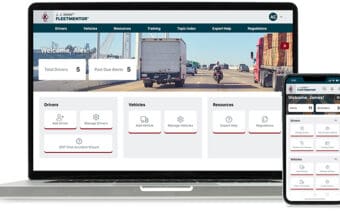
September 9, 2024
NORTHEAST WISCONSIN – Trying to do its part with sustainability efforts, Paper Transport, a De Pere-based trucking company, was recently recognized as a 2024 SmartWay® High Performer by the U.S. Environmental Protection Agency.
“It means we’re doing something right,” Ben Schill, CEO of Paper Transport, said.
Schill said the recognition was based on the performance of Paper Transport’s freight transportation operations.
“We’re doing certain things to become more fuel-conscious,” he said. “It boils down to how efficient you are regarding miles per gallon, and we are near the top regarding that.”
Schill said the industry average is close to seven miles per gallon.
“On average, our diesel trucks get about eight-and-a-half miles per gallon,” he said. “It makes me proud to say we made the list.”
In addition to this recognition, Schill said Paper Transport also submitted and received approval for its current data submission to the SmartWay Transport Partnership.
“Some shippers require you to be SmartWay certified to carry for them,” he said.
The partnership, Schill said, currently has nearly 4,000 partners, including shippers, logistics companies, truck, rail, barge and multimodal carriers.
Ways to improve fuel efficiency
With more than 800 trucks on the road, Schill said small changes can add up.
Schill said Paper Transport utilizes trailer skirts (a device for semi-trucks used to help reduce drag and therefore, help with fuel savings and improved trailer stability) and incorporates certain aerodynamic features on the trucks.

“There are small things you can do to help with fuel economy, but one of the major things we incorporate is driver education,” he said. “Our trucks are also governed to run a bit slower than most trucks as well – 63 miles per hour. You save fuel by doing that.”
Another area of education, Schill said, is when the truck isn’t on the road.
“That asset – the truck – is only working about eight hours per day,” he said. “The other 16 hours, it’s not producing miles. During that off time, is the truck still running or idling?”
With the recent heat wave Northeast Wisconsin saw, and doing a fair amount of work in the southeastern part of the United States, Schill said truck cabs can get hot.
“To keep things cool, the truck has to be on all night,” he said. “That burns approximately a gallon of fuel per hour – you’re going through a lot of fuel to keep the driver comfortable.”
Schill said another example might be when a driver is making a local delivery and is sitting with the truck running at a docking station for two hours because AC is needed.
“That’s two more gallons of fuel to keep that cab cool,” he said.
Paper Transport’s major project, Schill said, was “attacking idle time.”
“Our goal was to save 100,000 gallons of diesel fuel this year,” he said. “The ‘low-hanging fruit’ was to go after idle time. We made some spec changes on the truck. There is a sensor on it, so if the ambient temperature is at a comfortable range, the truck will automatically shut down after a couple of minutes. If it gets outside of that range, it will allow the driver to idle.”
Schill said thanks to that update, Paper Transport is on pace to save 107,000 gallons of diesel fuel this year.
“Most of the savings weren’t due to the spec changes to the trucks but more from the coaching of the drivers,” he said. “All our drivers rallied around it. We also pay close to a million dollars per year in bonuses for fuel performance, so that’s also a big piece behind it. With such a lofty goal, that’s a reduction of more than three million pounds of CO2 emissions per year.”
The future is now
Schill said he thinks too many companies – trucking organizations included – are thinking too much about the far-off distant future when EV trucks might be the norm instead of using what is available now to help in sustainability efforts.
“There’s a lot of dialogue with what the future will look like,” he said. “What matters – at least in my opinion – is what are you doing now? There are so many people waiting for electric (vehicles), but there are so many opportunities right now to take action – you don’t have to wait for the new stuff to come out. I feel there is too much pent-up optimism about what’s coming compared to what is available now. If you put all that energy into doing something today, you can make a difference.”
Instead of EVs, Paper Transport utilizes compressed natural gas.

“We are one of the largest compressed natural gas-powered fleets in North America,” he said. “We started using that in 2010 and were the first trucking company outside of the ports of Los Angeles to utilize that fuel.”
Schill said we have “oodles of renewable natural gas right under our feet.”
“A lot of our competitors were educating shippers on why compressed natural gas doesn’t work, but here we are, 14 years later – it works,” he said. “There are challenges like anything else, but I believe EVs are a perfect example of talking about what’s coming compared to doing something right now. Compressed natural gas is a fantastic bridge fuel to utilize.”
Schill said he thinks it’s the wrong mindset to say “it’s all or nothing” regarding the type of fuel or technology that can be utilized.
“One is through diesel, another is through renewable natural gas and there’s even talk about hydrogen,” he said. “Yes, there are some EV fleets up and running now, but it’s going to be a long run before it completely takes hold, especially in longer-haul operations.”
Though Paper Transport currently doesn’t utilize EVs, Schill said that could change in the future when the technology and infrastructure are there.
How renewable natural gas works
Schill said a lot of people get confused by the differences in natural gas extracted from the earth made by fossil fuels compared to renewable natural gas.
“For now, in my opinion, renewable natural gas is the best option,” he said. “All you have to do is take a drive down the highway to see how renewable natural gas works. You see many landfills where they are burning off that gas created (by the buried garbage). Manure pits are another source.”
Schill said companies like Paper Transport can capture that renewable natural gas from its different sources to use in its trucks.
“They either have to burn it off (as it escapes) or sell it to companies,” he said. “All of our operations in Southern California use renewable natural gas.”
Schill said that renewable natural gas is not converted to a liquid – but rather stays a gas.
“At least in our fleets, the gas is compressed to like 3,600 pounds, or something like that,” he said. “That compressed natural gas sits in a tank and runs the truck. The cool thing is, the technology is pretty simple.”
Schill said using compressed natural gas also has other benefits besides its value in sustainability efforts.
“It’s better for the driver,” he said. “By the end of a shift, they don’t smell like diesel fuel. I’ve been in this industry my whole career, so I’m used to smelling diesel with big, noisy, clanky trucks. When we had our first 12-liter natural (natural) gas truck parked outside of our old office, when we’d go outside and it was idling, it sounded like a GTO – a nice-sounding sports car. The noise factor is not there.”
 Wisconsin Aluminum Foundry celebrates 115 years of manufacturing
Wisconsin Aluminum Foundry celebrates 115 years of manufacturing Four recognized as 2023 Aurora Health Care Nurses of the Year
Four recognized as 2023 Aurora Health Care Nurses of the Year








